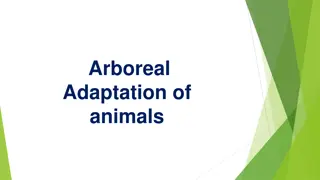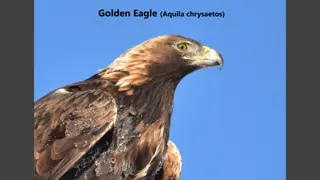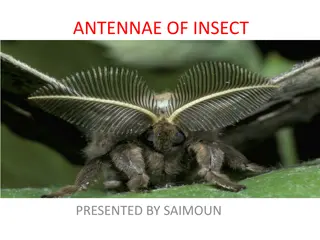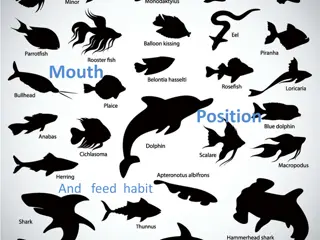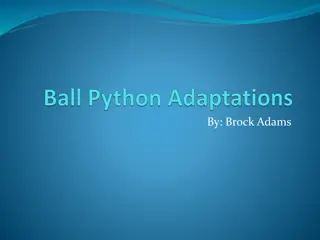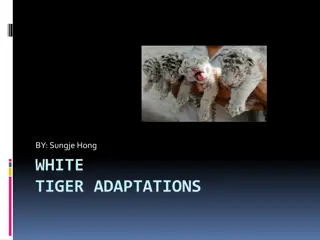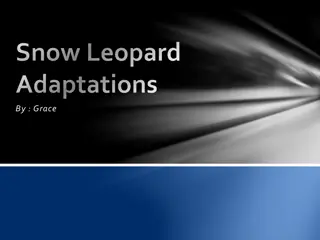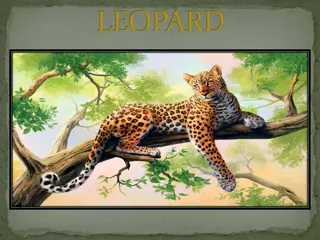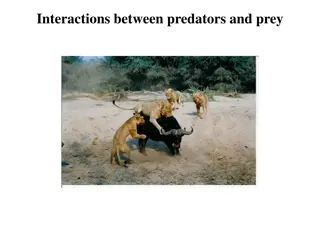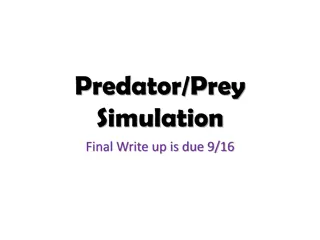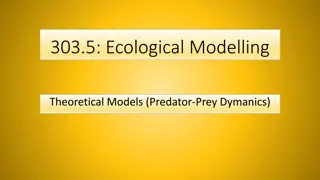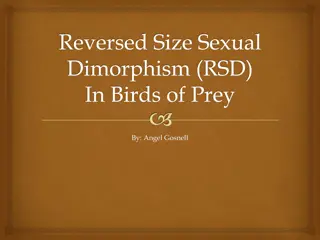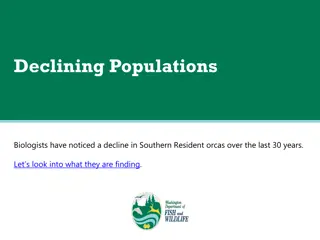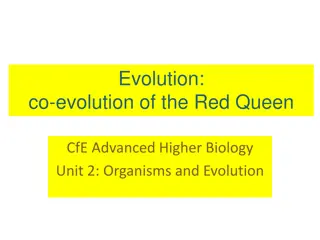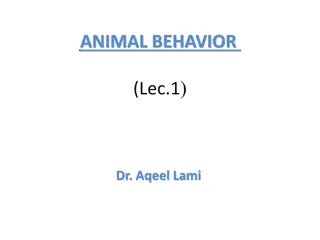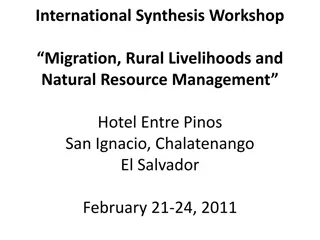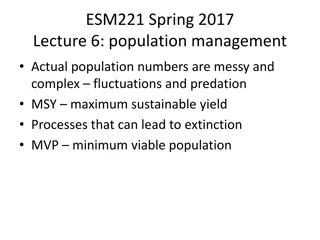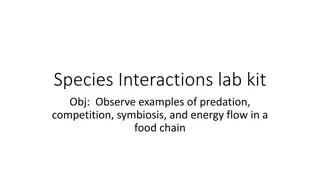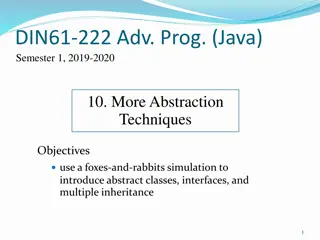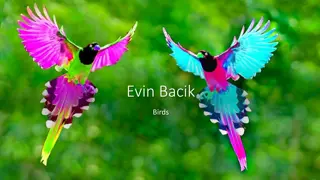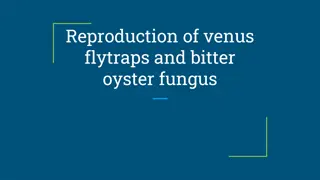Understanding Animal Camouflage and its Importance in Survival
Animal camouflage plays a crucial role in survival by allowing prey to blend in with their habitats to avoid predators, and enabling predators to effectively hunt for food. This natural adaptation enhances the chances of both prey and predators in the wild.
3 views • 46 slides
Understanding Species Interactions and Predator-Prey Dynamics
Species interactions refer to the associations between different organisms that can be positive or negative, influencing the growth and evolution of populations. Predation is a key interaction where one organism hunts and feeds on another. In predator-prey dynamics, populations fluctuate in a cyclic
3 views • 36 slides
The Warning of Worldliness in Revelation
The images and verses from Revelation 17 highlight the dangers of worldliness, spiritual adultery, and the deception of the world system. The vivid descriptions of a woman on a scarlet beast, symbolizing worldly allure and opposition to God, serve as a cautionary tale against being ensnared by the a
0 views • 19 slides
Fascinating Insights into Hammerhead Sharks
Hammerhead sharks, known for their unique hammer-shaped heads, are carnivorous creatures that primarily feed on fish, stingrays, and other sharks. They are swift swimmers, capable of outpacing many other shark species. These creatures inhabit various seas worldwide and have interesting interactions
0 views • 6 slides
Arboreal Adaptation of Chameleons
Chameleons, known for their arboreal lifestyle, possess unique adaptations for tree-dwelling, such as specialized feet for gripping branches and a long tail for balance. Their ability to change body color, protrusible tongue for catching prey, and sharp claws further enhance their survival in arbore
0 views • 19 slides
Understanding the Unique Features of Phylum Cnidaria in Life Science
Phylum Cnidaria comprises diverse marine animals like jellyfish, sea anemones, corals, and Hydra, exhibiting radially symmetric bodies with unique structures called cnidocytes. These cnidocytes serve as sensory-effector cells that contain specialized stinging organelles called cnidae, aiding in defe
0 views • 7 slides
Understanding Interdependence in Food Chains and Webs
Interdependence plays a crucial role in ecosystems where organisms rely on each other for survival. This interconnection is demonstrated through food chains and webs, highlighting the flow of energy and nutrients. Toxic materials can accumulate in food webs, disrupting the delicate balance. Changes
0 views • 13 slides
Fascinating Facts About Golden Eagles - Discover the Majesty of North America's Largest Bird of Prey
Learn intriguing details about golden eagles, including their lifespan, diet, wingspan, and key identifiers. Explore their habitat range, unique adaptations, and comparisons with other raptor species like bald eagles. Appreciate these magnificent birds as vital contributors to their ecosystems.
0 views • 7 slides
Understanding the Fascinating World of Insect Antennae
Insect antennae, also known as feelers, play a crucial role in sensory perception for insects. They help in detecting chemicals, perceiving various stimuli, and even aid in specialized functions like communication and prey-catching. The structure of antennae varies across insect species, showcasing
0 views • 11 slides
Understanding Fish Mouth Positions and Feeding Habits
The position of a fish's mouth reveals valuable information about its feeding habits, behavior, and lifestyle. Fish mouths can be categorized as superior (upward-facing), terminal (forward-facing), or inferior (downward-facing), each adapted for specific feeding strategies. Superior mouths are ideal
5 views • 10 slides
Understanding Ball Pythons: Fascinating Facts and Behaviors
Ball pythons, known for their heat pits and night vision, have fascinating adaptations for hunting and survival in the wild. They use camouflage to hide from predators, roll into a ball when scared, and have unique eye placement for 360-degree vision. These snakes thrive in savannah and thorn scrub
2 views • 8 slides
Understanding Sexual Assault Perpetrators: Dynamics, Behaviors, and Strategies
Explore the manipulative and opportunistic behaviors of sexual assault perpetrators, who prey on vulnerable victims and use power dynamics to assert control. Uncover common myths and stereotypes about perpetrators, and delve into investigative strategies to identify and address their actions effecti
0 views • 27 slides
Insights into White Tiger Adaptations and Behavior
Explore the adaptations of white tigers, including their teeth, camouflage, hunting habits, and unique tongue. Discover how these features help white tigers survive in their environments, such as blending into snowy landscapes and efficiently hunting prey. Gain insights into the physical characteris
0 views • 8 slides
Human Evolution: Out of Africa Hypothesis
The Out of Africa Hypothesis suggests that humans originated in Africa and then migrated to other parts of the world in two waves. The first migration occurred around 100,000 years ago, following the Nile River into the Middle East. The second migration, approximately 85,000 years ago, saw a group o
0 views • 59 slides
Explore Week 7: Devour, Dignified, Thunderous in Wildlife
Dive into the concepts of devouring, dignified behavior, and thunderous roars in the animal kingdom. Discover how big cats like lions exhibit dignified manners, tigers devour their prey, and the powerful presence of thunderous wildlife moments.
0 views • 16 slides
Snow Leopard - Amazing Adaptations and Behavior
Discover the fascinating world of snow leopards, known for their yellowish and grayish coat that provides camouflage in their mountainous habitat. With a population ranging from 3,500 to 7,000 in the wild, these majestic creatures exhibit unique characteristics such as a two-feet-tall stature and th
0 views • 6 slides
The Fascinating World of Leopards
Leopards, with their well-camouflaged fur and adaptable nature, thrive in the wild. They are solitary predators known for their opportunistic hunting behavior, broad diet, and ability to move heavy prey into trees. Unlike lions, leopards do not live in groups, and adult males live separately from fe
0 views • 8 slides
Birds of Prey Vocabulary and Expressions
Explore the vocabulary related to birds of prey such as eagle, hawk, scavenger, and more. Discover terms like perch, raptor, nocturnal, and extinct. Learn expressions like eagle eye and swoop with examples. Dive into the world of these fascinating creatures and their characteristics.
0 views • 8 slides
Understanding Interactions in Ecology
Living things interact with their environment and each other in various ways, leading to concepts like population dynamics, limiting factors, and species interactions such as competition, coevolution, predator-prey relationships, and symbiosis. These interactions shape ecosystems and influence the s
0 views • 9 slides
Understanding Predator-Prey Interactions: Impacts and Equilibria
Explore the dynamics of predator-prey interactions, including what defines a predator, the impacts predators have on prey populations, and the equilibrium points in the Lotka-Volterra Predator-Prey model. Discover how predation plays a crucial role in regulating population densities and observe the
0 views • 36 slides
Test Your Knowledge with Food Web and Food Chains Quiz
Explore the fascinating world of food chains and webs through this interactive quiz. Test your understanding of consumers, producers, predators, prey, herbivores, carnivores, and more. Challenge yourself to identify different roles in ecosystems and how organisms depend on each other for survival.
0 views • 22 slides
Predator-Prey Relationship Analysis in Natural Environments
Explore the interconnected dynamics of predator and prey populations in a natural environment through a simulation study. Investigate the impact of this relationship on the negative feedback process over time. Plan variables, predict ratios, provide examples, list materials, and outline the procedur
0 views • 11 slides
Understanding Lotka-Volterra Model for Predator-Prey Dynamics
The Lotka-Volterra model explores the intricate interactions between predator and prey populations, depicting oscillations in their sizes where the predator's peak lags behind the prey's. This model makes assumptions about exponential prey growth, predator starvation in prey absence, and unlimited p
0 views • 9 slides
Understanding Reversed Size Sexual Dimorphism in Birds of Prey
Reversed Size Sexual Dimorphism (RSD) in birds of prey challenges the traditional norm where females are larger than males. This phenomenon can be advantageous to both sexes in terms of ecological niche partitioning, role differentiation, and behavioral adaptations. The study focuses on the Strigifo
0 views • 14 slides
Conservation Challenges Facing Southern Resident Orcas
Biologists have observed a decline in Southern Resident orcas over the past three decades, attributing it to a lack of prey, toxic contaminants, and disturbance from noise and vessel traffic. Being listed as endangered signifies a species is at severe risk of extinction. Understanding the impact of
4 views • 8 slides
Interactions Among Living Things and Adaptations in Nature
Understanding the interactions among living things, such as competition, predation, and symbiosis, sheds light on how organisms adapt to their environments through natural selection. Each organism occupies a unique niche, defining its role in the ecosystem. Predation plays a crucial role in populati
0 views • 14 slides
Understanding Co-evolution: A Closer Look at the Red Queen Hypothesis in Biology
Co-evolution refers to the reciprocal genetic changes in species in response to each other. The Red Queen Hypothesis, illustrated in the arms race between parasites and hosts, exemplifies this phenomenon. This interaction drives evolutionary dynamics in herbivores, plants, pollinators, prey, predato
0 views • 18 slides
Understanding Animal Behavior and Ecology
Animal behavior encompasses a range of activities such as feeding, breeding, and social interactions. Ethology focuses on studying behavior in natural environments, while behavioral ecology examines ecological aspects like predator-prey interactions. Sociobiology delves into the evolution of social
3 views • 5 slides
International Workshop on Migration and Rural Livelihoods in Cambodia
Workshop highlights key issues on migration, rural poverty, and natural resource management in Cambodia. The event featured discussions on case study sites in Battambang, Prey Veng, and Phnom Penh, emphasizing labor migration, urbanization, and development cycles impacting livelihoods.
0 views • 17 slides
Grey Wolf Optimizer: A Nature-Inspired Optimization Algorithm
The Grey Wolf Optimizer algorithm is based on the social hierarchy of grey wolves in the wild. Inspired by the pack behavior of grey wolves, this algorithm utilizes alpha, beta, and delta solutions to guide the optimization process. The hunting phases of tracking, pursuing, and attacking prey mimic
3 views • 16 slides
Understanding Lotka-Volterra Model in Mathematical Modelling
Explore the dynamics of predator-prey systems through the Lotka-Volterra model, including equilibrium points, behavior around equilibria, linearization, eigenvalue analysis, and classification of equilibria based on real and complex eigenvalues.
2 views • 14 slides
Understanding Predator-Prey Population Cycles: Analysis and Insights
Explore the dynamics of predator-prey population cycles through mathematical models, linearization techniques, sensitivity testing, and conclusions on the role of maturation delay in shaping cycle periods and relationships between species.
2 views • 11 slides
Population Management and Sustainable Harvesting Strategies
Actual population numbers exhibit complex fluctuations influenced by predation and other factors. Understanding concepts like Maximum Sustainable Yield (MSY) and Minimum Viable Population (MVP) can help in managing populations effectively. The concept of MSY ensures the maximum harvest of a renewabl
0 views • 32 slides
Exploring Species Interactions in a Lab Setting
Discover examples of predation, competition, symbiosis, and energy flow in a food chain through interactive lab stations. From predator-prey relationships to mutualistic interactions, observe and learn about ecological dynamics in a hands-on environment.
0 views • 5 slides
Fascinating Facts About Dolphins
Dolphins consume a variety of prey including fish, squid, and crustaceans. They are able to breathe both water and air, showcasing their incredible adaptability. With a preference for cold climates and a natural shelter in the form of gulfs, dolphins are fascinating marine mammals that captivate and
0 views • 5 slides
Exploring the Characteristics of Phylum Cnidaria
Phylum Cnidaria, derived from the Greek word meaning stinging nettle, encompasses various marine species like jellyfish, sea anemones, and corals. These animals exhibit traits such as being diploblastic, with an ectoderm and endoderm separated by mesogloea. They possess a gastrovascular cavity, nema
0 views • 27 slides
Introduction to Abstraction Techniques using Foxes and Rabbits Simulation
Explore the benefits of simulation in predicting wildlife impact and balance in predator-prey relationships through a Java program simulating foxes and rabbits. Learn about important classes, behaviors of rabbits, and the overall simulation setup.
2 views • 53 slides
Lake Michigan Ecosystem Trends and Harvest Data
Explore the ecological trends and harvest data in Lake Michigan through images depicting mussel populations, water clarity, fish abundance, historic prey biomass, sport harvest numbers, predator-prey ratios, and salmon stocking figures. Gain insights into the dynamics of the lake's ecosystem and fis
0 views • 20 slides
Fascinating Facts About Birds: From Egg-laying to Hunting Techniques
Birds are warm-blooded creatures with feathers and wings, ranging from tiny hummingbirds to large albatrosses. They lay eggs and build nests in various ways. Some birds, like falcons, are skilled hunters, using their speed and agility to catch prey. Explore the intriguing world of birds and their be
0 views • 5 slides
The Fascinating Reproduction and Characteristics of Venus Flytraps and Bitter Oyster Fungus
Venus flytraps are carnivorous plants native to North and South Carolina, while bitter oyster mushrooms belong to the Mycenaceae family and exhibit bioluminescent properties. Each has unique genetic makeup affecting their reproduction. Venus flytraps have evolved to catch prey with trigger hairs on
0 views • 7 slides




